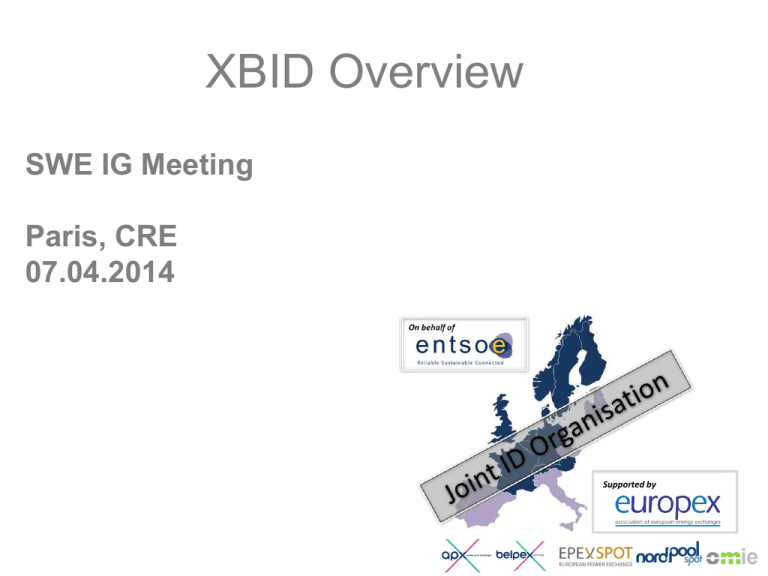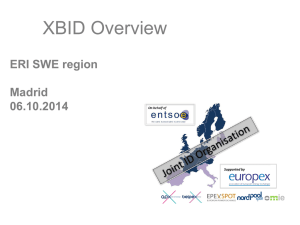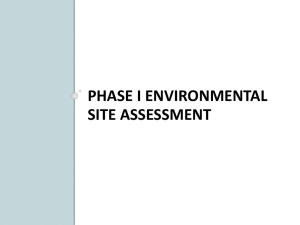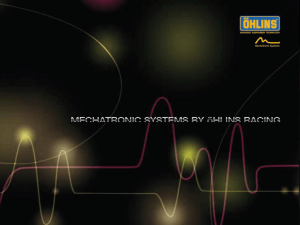Kick off Legal & Contract TF
advertisement

XBID Overview SWE IG Meeting Paris, CRE 07.04.2014 Supported by Agenda • Project structure and interfaces • High level overview of current project status • XBID Joint project approach • High level PX project plan with DBAG • Early Start Agreement Step 1 – Overview & Timeline • Update on Shipping and Nomination • Summary and discussion Project structure and interfaces High level overview of current status (1) • Cost recovery – Letter of Cost Comfort has been received by PXs and TSO’s; it confirms 100% recovery of allowed costs subject to conditions. ‘NWE+’ TSOs have confirmed their agreement to the ‘NWE+’ PX’s. • PXs’ Cooperation Agreement (PCA) – Agreement has been reached between the PX’s to enable the Agreement with DBAG to be signed • PX/TSO Joint Project - Project Management Core Team established – program management coordination reflecting the Joint Project, PXs and TSOs. Core team meets weekly and reviews high level issues and resolution. - Joint Steering Group, Co-ordination Team and 3 Task Forces (Legal, IT and Pre & Post Coupling) are in place with members from both PX’s and TSO’s present in each High level overview of current status (2) • Delivery of Early Start Agreement (ESA) Step 1 – Progress has been made to complete this phase which defines the content of the solution to be developed » Investment in this phase provides the foundation for all parties – We are tackling challenging issues which are essential for the long term success of the project but which are taking time to resolve. These include: » Equal Treatment » Performance » Testing – We have a plan to complete ESA Step 1 by Easter which remains a challenge. We have an approach to close open issues if any remain at this point • Initial ideas have been shared on developing the future model for shipping and nomination XBID Joint project approach Design Local /regional Implementation projects Local /Regional Implementation Projects (LIPs) Roadmap interim Solution LIPs framework conditions satisfied Common framework for pre- and postcoupling Roadmap info from LIPs Follow-up/coordinate implementation of Interim Solution Coordinate Design and Development of Interim Solution (monitoring and directing) XBID Interim Solution delivered and accepted D&D contract Business Blueprint Project under ESA Project under contract High level PX project plan with DBAG 6 weeks 4 months 1 year (depends on the project planning in ESA Step 1) ESA Signature Project under ESA ESA Step 1 Project Planning Activi ties (for ESA Step 2 onwards) Quality planning Project under Contract ESA Step 2 Design and Development Business Blueprint FAT & IAT Development and infrastructure D&D Contract Negotiation UAT Maintenance Contract Negotiation Early Start Agreement Step 1 - Overview Description of ESA deliverables: Delivery Prior Step 1 Specification of basic principles on project documentation (e.g. documentation management) Delivery 1 Project terms and principles of equal treatment Delivery 3 Batch 1 Project management principles for handling of issues, changes, risks and communication Delivery 3 Batch 2 Project and quality planning, definition of the work products, test strategy Commence ESA Step 2 Early Start Agreement Step 1 - Timeline 02.04.14 17.1.2014 ESA Step 1 Delivery 1 Delivery 3 Batch 1 ESA validation by Vendor board Delivery 3 Batch 2 ESA validation by PX boards ESA ready to be signed PCA - SC approval of 2nd step assessment ESA signed PCA ready to be signed 24.1.14 PCA signed 3.2.14 - Delay with significant impact 13.2.14 - Completed 15.04.14 - Date Beginning May14 Comfort Letter issued Decision on ESA Step 2 Stakeholder Review &Confirmation Lessons Learnt Review Mobilisation ESA Step 2 Delivery Prior Step 1 Update on Shipping and Nomination • • • • • • An Intraday continuous capacity allocation market imposes far more challenging requirements to the shipping and nomination process than for the Day Ahead (DA) market – Cross-border allocation settlement processes must be concluded within a short period before real time to facilitate the short gate closure times – This requires high robustness of the TSO operational processes to conclude the crossborder capacity allocation settlement into the required schedules (e.g. for controlled devices: load frequency controllers, phase shifters & DC cable flows) The two options on cross-border nomination are being evaluated – 1) Border to border and 2) Hub to hub TSO’s perspective: The existing DA solutions for shipping and nomination will have limited geographic scope for the scale of implementation required to facilitate an orderly Intraday market on a pan-European scale. A hub to hub approach may be necessary. 4 aggregation options of functions for shipping and nomination have been identified for the above 2 options, which gives a total of 8 potential options to be evaluated Joint assessment of a potential centralised solution and the governance implications needs to completed. High level scoring on quality, costs, implementation time and future proofing has started at a working level and will be progressed over the coming weeks. There are resource constraints at present due to the priority on completing ESA Step 1 Full resolution of this topic is needed before start of LIPs. The immediate need, so as to ensure that the blueprint phase is not delayed, is to look at functional implications, if any, with an impact on the XBID system. Summary and discussion • Whilst progress has been made with ESA Step 1 the process and complexity, together with challenges of reaching alignment have been significant. All parties are striving to resolve key issues rather than allowing these to cause subsequent project delays • These key issues involve Equal Treatment, Performance and Testing • The extension of ESA Step 1 has involved additional cost • All parties are targetting completion of ESA Step 1 by Easter which remains a challenge. There is a plan to allow a short period to ensure full agreement to Step 1 (including as necessary with NRAs) before starting Step 2. This also allows for a “lessons learnt project review” to improve processes • It is expected that a period of around 12-13 months will be required to deliver the XBID solution. It is essential that aspects such as Integration Testing are included to ensure robust implementation. • Agreeing the future model for shipping and nominations is key. The different options being considered have varying impacts on implementation timescales, the costs of the solution and scalability. • Development of the Local Implementation Projects (LIPs) and roadmap is to be undertaken once the Business Blueprint phase is completed. Where possible and subject to confirmation LIP implementation will be run in parallel with the XBID solution project











